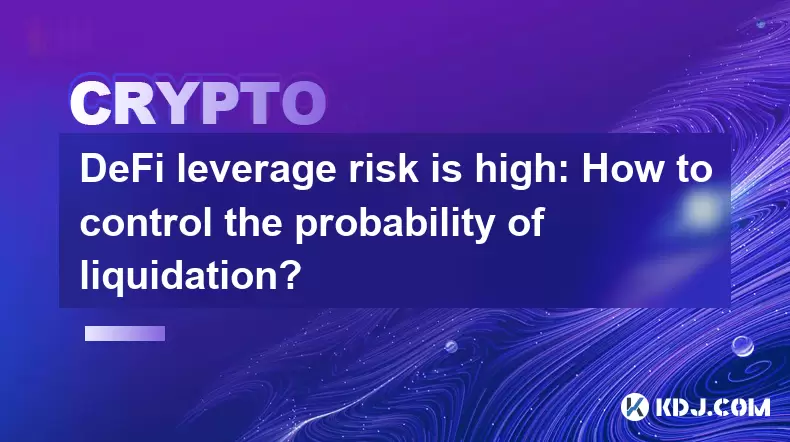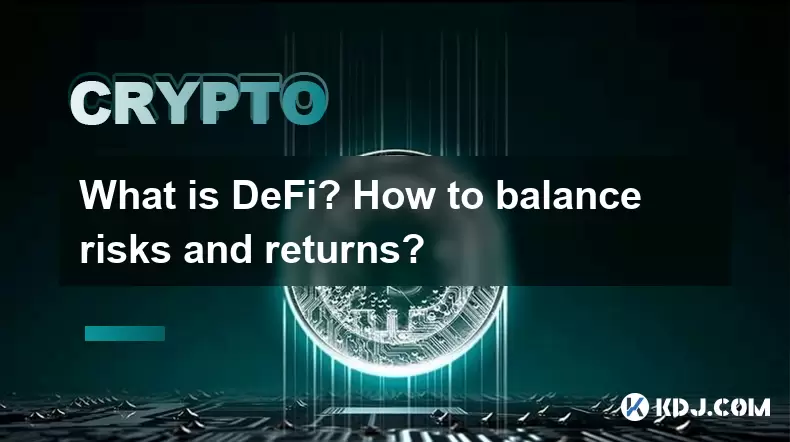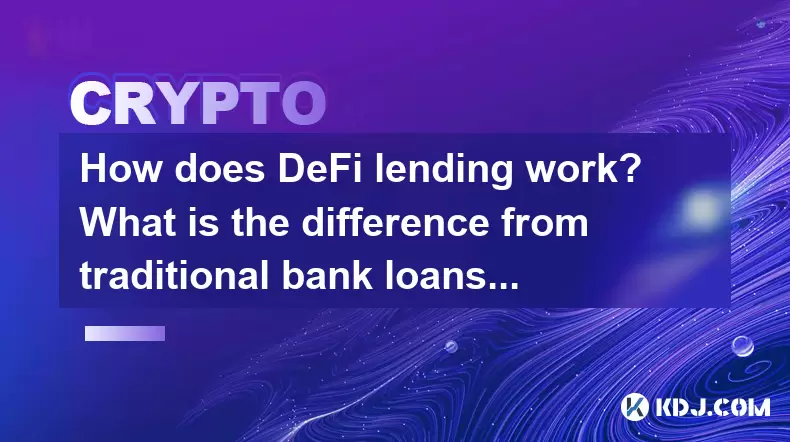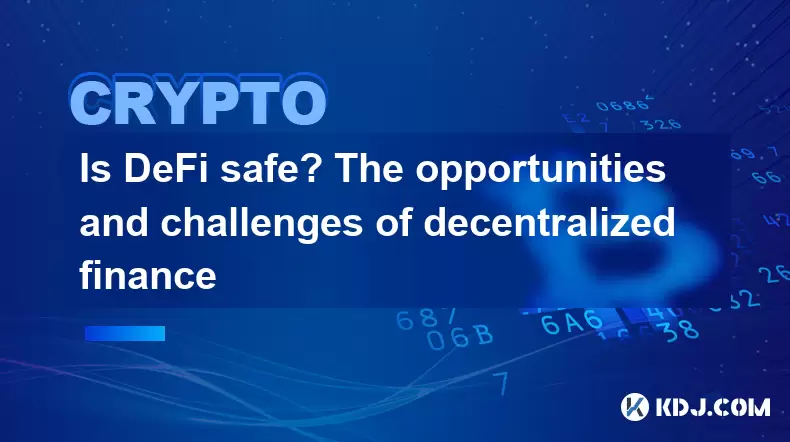-
 bitcoin
bitcoin $114779.865156 USD
2.30% -
 ethereum
ethereum $4226.519789 USD
2.39% -
 tether
tether $1.000545 USD
0.04% -
 xrp
xrp $2.890223 USD
0.92% -
 bnb
bnb $1030.029301 USD
2.95% -
 solana
solana $212.824944 USD
1.69% -
 usd-coin
usd-coin $0.999757 USD
0.01% -
 dogecoin
dogecoin $0.234961 USD
-0.27% -
 tron
tron $0.337174 USD
0.42% -
 cardano
cardano $0.804783 USD
0.09% -
 hyperliquid
hyperliquid $45.748770 USD
-2.85% -
 chainlink
chainlink $21.699170 USD
0.82% -
 ethena-usde
ethena-usde $1.001452 USD
0.08% -
 avalanche
avalanche $30.237800 USD
1.14% -
 stellar
stellar $0.372604 USD
1.52%
DeFi leverage risk is high: How to control the probability of liquidation?
DeFi leverage lets users amplify investments but risks liquidation if collateral value drops below thresholds; strategies like monitoring and adjusting positions can mitigate this risk.
May 08, 2025 at 03:09 am

Understanding DeFi Leverage and Liquidation
DeFi, or Decentralized Finance, has revolutionized the way users interact with financial services on the blockchain. One of the most popular features within DeFi is leverage, which allows users to borrow funds to amplify their investment potential. However, with great power comes great risk, particularly the risk of liquidation. Liquidation occurs when the value of a user's collateral falls below a certain threshold, prompting the platform to sell the collateral to cover the borrowed amount. This article will explore how to control the probability of liquidation when using leverage in DeFi.
The Mechanics of Leverage and Liquidation
In DeFi, leverage is typically achieved through borrowing against collateral. For instance, a user might deposit Ethereum as collateral to borrow DAI, a stablecoin. The borrowed DAI can then be used to purchase more Ethereum, effectively increasing the user's exposure to Ethereum's price movements. However, if the price of Ethereum drops significantly, the value of the collateral may no longer be sufficient to cover the borrowed amount, triggering liquidation.
Liquidation thresholds vary between platforms but are generally set to ensure the platform's solvency. Understanding these thresholds is crucial for managing the risk of liquidation. For example, if a platform has a liquidation threshold of 80%, the collateral must maintain a value of at least 80% of the borrowed amount to avoid liquidation.
Strategies to Control Liquidation Risk
To mitigate the risk of liquidation, users can employ several strategies. These strategies focus on maintaining a healthy collateral-to-debt ratio and being proactive in managing positions.
1. Monitor Collateral Value and Debt Levels
Regularly monitoring the value of your collateral and the amount of debt you have is essential. Use tools and dashboards provided by DeFi platforms to keep an eye on your positions. If the value of your collateral starts to approach the liquidation threshold, you can take action to prevent liquidation.
- Check your position frequently using the platform's interface or third-party tools.
- Set up alerts for when your collateral value nears the liquidation threshold.
2. Adjust Collateral and Debt
If you notice that your collateral value is nearing the liquidation threshold, you can take steps to adjust your position. This might involve adding more collateral or repaying some of the debt.
- Add more collateral to increase the collateral-to-debt ratio.
- Repay part of the debt to reduce the amount that needs to be covered by the collateral.
3. Use Stop-Loss Orders
Some DeFi platforms and third-party services offer stop-loss orders, which can automatically close your position if the collateral value drops to a certain level. This can help prevent liquidation by selling your assets before the threshold is reached.
- Set a stop-loss order at a level above the liquidation threshold to ensure your position is closed before liquidation occurs.
4. Diversify Collateral
Diversifying the assets used as collateral can help mitigate the risk of liquidation. If one asset's value drops significantly, other assets in the collateral pool may help maintain the overall value above the liquidation threshold.
- Use a mix of stablecoins and volatile assets as collateral to balance risk and stability.
Choosing the Right DeFi Platform
The choice of DeFi platform can significantly impact your ability to manage liquidation risk. Different platforms offer varying levels of flexibility and tools to help users manage their positions.
1. Evaluate Platform Features
Look for platforms that offer features such as adjustable liquidation thresholds, real-time monitoring tools, and the ability to add or withdraw collateral easily.
- Research the platform's liquidation policies and ensure they align with your risk tolerance.
- Check for user-friendly interfaces that make it easy to monitor and adjust your positions.
2. Understand the Platform's Risk Management Tools
Some platforms provide advanced risk management tools, such as dynamic interest rates that adjust based on the platform's overall risk exposure. Understanding these tools can help you better manage your positions.
- Learn about the platform's interest rate model and how it impacts your borrowing costs.
- Utilize any available risk management features to your advantage.
Case Study: Managing a Leveraged Position
To illustrate how these strategies can be applied, let's consider a hypothetical scenario where a user, Alice, wants to leverage her Ethereum holdings to increase her exposure to the cryptocurrency.
Alice's Initial Position
- Collateral: 10 ETH
- Borrowed Amount: 5,000 DAI
- Liquidation Threshold: 80%
Alice's initial collateral-to-debt ratio is healthy, with the value of her 10 ETH well above the 5,000 DAI she borrowed. However, she knows that the price of Ethereum can be volatile and wants to manage her risk carefully.
Monitoring and Adjusting
Alice sets up alerts to notify her if the value of her collateral approaches the liquidation threshold. She also regularly checks her position using the platform's dashboard.
One day, the price of Ethereum drops significantly, and Alice's collateral value nears the 80% liquidation threshold. She quickly takes action:
- Adds 2 more ETH to her collateral to increase the collateral-to-debt ratio.
- Repays 1,000 DAI of her debt to reduce the amount that needs to be covered by the collateral.
By taking these steps, Alice successfully avoids liquidation and maintains her leveraged position.
Frequently Asked Questions
What are the signs that my leveraged position is at risk of liquidation?
The primary sign that your leveraged position is at risk of liquidation is when the value of your collateral approaches the platform's liquidation threshold. You can monitor this through the platform's dashboard or by setting up alerts. Additionally, a sudden drop in the value of the assets you hold as collateral or an increase in the borrowed amount can also indicate an increased risk of liquidation.
Can I recover my assets after liquidation?
After liquidation, the platform sells your collateral to cover the borrowed amount. Any remaining value after the debt is settled is typically returned to you. However, if the value of the collateral drops below the borrowed amount, you may lose your entire collateral. It's important to understand the platform's liquidation process and any potential fees involved.
How does the choice of collateral affect liquidation risk?
The choice of collateral can significantly impact liquidation risk. Using volatile assets as collateral increases the risk of liquidation due to their price fluctuations. Conversely, using stablecoins or less volatile assets can help maintain a more stable collateral-to-debt ratio. Diversifying your collateral with a mix of assets can also help mitigate risk.
Are there any DeFi platforms that offer better protection against liquidation?
Some DeFi platforms offer features that can help protect against liquidation, such as adjustable liquidation thresholds, real-time monitoring tools, and the ability to easily add or withdraw collateral. Platforms like Compound and Aave are known for their robust risk management features. It's essential to research and compare different platforms to find one that aligns with your risk management needs.
Disclaimer:info@kdj.com
The information provided is not trading advice. kdj.com does not assume any responsibility for any investments made based on the information provided in this article. Cryptocurrencies are highly volatile and it is highly recommended that you invest with caution after thorough research!
If you believe that the content used on this website infringes your copyright, please contact us immediately (info@kdj.com) and we will delete it promptly.
- BlockDAG, DOGE, HYPE Sponsorship: Crypto Trends Shaping 2025
- 2025-10-01 00:25:13
- Deutsche Börse and Circle: A StableCoin Adoption Powerhouse in Europe
- 2025-10-01 00:25:13
- BlockDAG's Presale Buzz: Is It the Crypto to Watch in October 2025?
- 2025-10-01 00:30:13
- Bitcoin, Crypto, and IQ: When Genius Meets Digital Gold?
- 2025-10-01 00:30:13
- Stablecoins, American Innovation, and Wallet Tokens: The Next Frontier
- 2025-10-01 00:35:12
- NBU, Coins, and Crypto in Ukraine: A New Yorker's Take
- 2025-10-01 00:45:14
Related knowledge

How to track DeFi activity on a block explorer
Sep 04,2025 at 05:36pm
Bitcoin's Role in Decentralized Finance1. Bitcoin remains the cornerstone of the cryptocurrency ecosystem, serving as both a store of value and a benc...

What is the difference between DeFi and CeFi? An article analyzing the advantages and disadvantages of both
Jun 13,2025 at 03:57am
Understanding the Foundations of DeFi and CeFiTo fully grasp the difference between DeFi (Decentralized Finance) and CeFi (Centralized Finance), it’s ...

What is DeFi? How to balance risks and returns?
May 31,2025 at 12:22pm
What is DeFi? How to Balance Risks and Returns? Decentralized Finance, commonly known as DeFi, represents a revolutionary shift in the financial ecosy...

How does DeFi lending work? What is the difference from traditional bank loans?
May 29,2025 at 05:36pm
Introduction to DeFi LendingDeFi lending, or decentralized finance lending, represents a revolutionary shift in the way borrowing and lending are cond...

Is DeFi safe? The opportunities and challenges of decentralized finance
May 27,2025 at 02:28pm
Decentralized Finance, commonly known as DeFi, has revolutionized the financial landscape by offering a range of financial services without the need f...

DeFi Mining Tutorial: How to Maximize Profits and Reduce Risks?
May 27,2025 at 07:42am
DeFi, or Decentralized Finance, has opened up a new world of opportunities for crypto enthusiasts looking to maximize their profits through various mi...

How to track DeFi activity on a block explorer
Sep 04,2025 at 05:36pm
Bitcoin's Role in Decentralized Finance1. Bitcoin remains the cornerstone of the cryptocurrency ecosystem, serving as both a store of value and a benc...

What is the difference between DeFi and CeFi? An article analyzing the advantages and disadvantages of both
Jun 13,2025 at 03:57am
Understanding the Foundations of DeFi and CeFiTo fully grasp the difference between DeFi (Decentralized Finance) and CeFi (Centralized Finance), it’s ...

What is DeFi? How to balance risks and returns?
May 31,2025 at 12:22pm
What is DeFi? How to Balance Risks and Returns? Decentralized Finance, commonly known as DeFi, represents a revolutionary shift in the financial ecosy...

How does DeFi lending work? What is the difference from traditional bank loans?
May 29,2025 at 05:36pm
Introduction to DeFi LendingDeFi lending, or decentralized finance lending, represents a revolutionary shift in the way borrowing and lending are cond...

Is DeFi safe? The opportunities and challenges of decentralized finance
May 27,2025 at 02:28pm
Decentralized Finance, commonly known as DeFi, has revolutionized the financial landscape by offering a range of financial services without the need f...

DeFi Mining Tutorial: How to Maximize Profits and Reduce Risks?
May 27,2025 at 07:42am
DeFi, or Decentralized Finance, has opened up a new world of opportunities for crypto enthusiasts looking to maximize their profits through various mi...
See all articles










































































